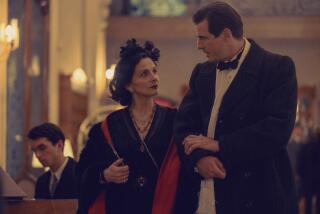A Second Look: The urgency of ‘Germany in Autumn’
Omnibus films, those multi-episode endeavors that string together the contributions of disparate talents, are uneven almost as a rule. But the jaggedness and nagging irresolution of 1978’s “ Germany in Autumn” — a collaboration among 11 filmmakers, most of them associated with the German New Wave of the period — points to a desperate sense of urgency about a prevailing mood of confusion.
In the span of a chaotic few months that came to be known as the German Autumn (partly thanks to this film), the German Republic existed in perpetual crisis mode. In early September 1977, members of the Red Army Faction, a far-left militant group, abducted Hanns-Martin Schleyer, an industrialist (and former SS officer), and demanded the release of their imprisoned associates.
A month later, the RAF hijacked a Lufthansa jet. Within a few days, three RAF members who were serving life sentences were found dead in prison. Their deaths were ruled suicides; Schleyer’s kidnappers later executed him.
Filmed as these events were unfolding and completed shortly thereafter, “Germany in Autumn” (new to DVD from Facets) is a visceral response to the bleak national mood, coordinated by the filmmaker Alexander Kluge, who recruited such prominent colleagues as Rainer Werner Fassbinder and Volker Schlöndorff. The film proceeds in fits and starts, frequently interrupting itself and circling back. There are no identifying titles separating the segments, many of which are open-ended and some of which are threaded throughout.
A few are fictional vignettes — a tense border crossing, an atmospheric encounter between a pianist and a bloodied stranger who shows up at her front door — but more than half the film is given over to documentary footage.
Bookended by funerals, “Germany in Autumn” opens with Schleyer’s solemn state memorial service and closes with the unceremonious burials, attended by a few scattered sympathizers, of RAF leaders Andreas Baader, Gudrun Ensslin and Jan-Carl Raspe.
Also included: a prison-cell interview with Horst Mahler, an RAF founder, and some fly-on-the-wall passages observing the bustle of caterers at Schleyer’s funeral and the discomfort of assembly-line workers at a Daimler-Benz plant asked to observe a moment of silence.
Alternating between documentary and fiction, “Germany in Autumn” often blurs the two. Kluge’s contribution, which he expanded into a separate feature, “The Patriot,” concerns a history teacher wrestling with the fictions of the past. (The memory of the Third Reich looms unavoidably large.)
A few segments are self-consciously framed as comments on political art. In one, a young filmmaker applies the principles of Soviet revolutionary cinema to current events. In another, a boardroom of executives debate a TV version of Sophocles’ “Antigone,” which they fear might be seen as pro-terrorist.
But it’s Fassbinder who most decisively demolishes the lines between drama and reality and between the personal and the political. In his section, which bristles with the full force of his personality, Fassbinder plays himself — or perhaps a heightened version, a strung-out workaholic despairing over the political crisis, which is here intimately connected to his own inability to function.
Blocked, stressed, paranoid, he butts heads with his downtrodden lover, Armin Meier, who believes the terrorists should be executed, and with his mother, Lilo Pempeit, whom he engages in a back-and-forth over the principles of democracy and the value of free discussion; the film ends with him goading her into a jolting admission that she longs for a simpler, more authoritarian time.
Fassbinder took on the subject of terrorism again in his 1979 masterpiece “The Third Generation.” The tragic story of the radical left in the ‘70s — a painful, violent hangover that followed the failed revolution of the ‘60s — has proved to be fertile terrain for filmmakers around the world. Schlöndorff made “The Lost Honor of Katharina Blum” (1975) with his then wife, Margarethe von Trotta, about a woman whose life is destroyed by an association with a terrorist, and produced a companion piece with “The Legend of Rita” (2000).
Uli Edel’s “The Baader Meinhof Complex” (2008) and Olivier Assayas’ recent “Carlos” both consider the mythic figure of the ‘70s outlaw terrorist, and Koji Wakamatsu’s “United Red Army” (2007) examines in grueling detail the self-destructive collapse of an extremist faction of Japanese militants.
What many of these films share is the benefit of hindsight. “Germany in Autumn” is a rarer beast — a political film that attempts to capture a time and place before a context has fully formed around it. It demonstrates many of the problems that come with this approach — the film can seem myopic and ungrounded — but its immediacy more than makes up for its shortcomings.
It’s an essential record, less of defining events than of the conflicting responses they produced, before they hardened and receded into history.
More to Read
The biggest entertainment stories
Get our big stories about Hollywood, film, television, music, arts, culture and more right in your inbox as soon as they publish.
You may occasionally receive promotional content from the Los Angeles Times.






